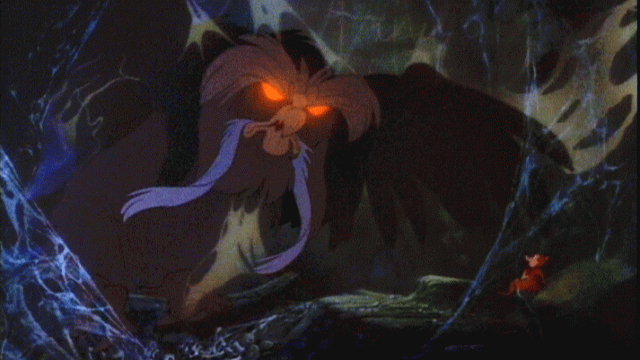There are many movies that bear revisiting as your life circumstances change. A movie watched at eight, or nineteen, or thirty, is a new film, watched by a new person. But I’m not sure I’ve felt the change more profoundly than when I revisited The Secret of NIMH with my elementary-school daughter at my side.
The Secret of NIMH was rare in its time, and remains rare still, for its focus on motherhood. Its lead character, Mrs. Brisby (Frisby in the original novel, Mrs. Frisby and the Rats of NIMH, changed for rather silly copyright reasons) is not a new mother or an innocent waif. She’s a widowed parent of four, living in a dangerously vulnerable part of a field that’s due to be plowed. Her journey is not for the sake of glory or jewels or to solve a great mystery; she just wants to keep her family safe. It’s as quotidian a goal as they come. (In the book, there’s not even a magic amulet, just science; in both, the rats are also looking for a permanent, safe, home.)
While the idea of fighting for home and family is well-known in children’s media (children still read the Boxcar Children books, and Watership Down when they’re young enough to be traumatized by it), it’s less common in movies, which love fantastical journeys to one place or another or struggles over global power. (The Lord of the Rings, one of the most journey-heavy fantasy tales, is another home-based epic, as is Toy Story, on a more metaphorical scale.) To an adult, the addition of a supernatural amulet feels jarring, and I didn’t like it much better as a child, especially when I devoured Mrs. Frisby and the Rats of NIMH and realized it had been added to the adaptation. But it does work well on a symbolic level, as Mrs. Brisby’s incredible strength, courage, and love for her family moves her family’s endangered home to safety.
The stakes are a bit unusual, but the structure of The Secret of NIMH is still plenty familiar — a series of internal and external challenges with increasing stakes, secrets revealed, and allies both heroic and untrustworthy. The film balances the fantastic and science fiction elements of its plot with the much more everyday threats of the plow, the owl, and the cat. There’s a whole hidden world that Mrs. Brisby has to navigate, and it is all unfamiliar and intimidating to her. Don Bluth’s animation team does an incredible job of showing the danger and unfamiliarity of the world beyond her field. The scene with the Great Owl (John Carradine!) is straight-up terrifying, and the NIMH sequence was at least one’s generation’s introduction to what really could happen to lab mice. The world outside the field is scary, and the late Jonathan Brisby’s past is heroic, but filled with loss.
The child’s eyes see a world full of danger and wonder; the adult does, too, but the danger, especially those everyday ones of hunger, illness, and homelessness, seems much darker. Adults understand just how brief and fragile the lives of rats and mice are. Adults understand what it’s like to look at a bill and wonder what the most responsible way is to pay it. Watching as a parent, Mrs. Brisby’s choices are profoundly familiar, even as the setting isn’t.
By the time my kid was sitting next to me on our couch, I’d had my own confrontation with the Great Owl. As I write this essay, I’d had to make sure my home was in the lee of the stone. (In fact, someone’s working on the furnace as I make my final edits.) When I watched The Secret of NIMH as a child, did any part of me recognize how Mrs. Brisby’s struggles might become my own? I can’t imagine how. Searching on the internet, I am not certain any of the film’s four credited scriptwriters are parents, and all of them are men, but they still captured parenthood, motherhood and devotion better than a lot of movies written by and for adults. (All credit to the source material as well, of course; Robert O’Brien was a father of four.)
Mrs. Brisby, of course, was succeeded by some, if not many, heroic mothers in children’s movies, most notably Helen/Elastigirl of the Incredibles franchise. (Would Merida’s mother in Brave have made this list, if things had gone differently? Hard to say.) Then, as now, it’s inspiring to see children wanting to be like their heroes, especially when those heroes are parents. Now, it’s inspiring to think that we might — and can — find that heroism inside ourselves when it matters.
The voice cast for this movie is excellent, but of course, Elizabeth Hartman as Mrs. Brisby is the make-or-break performance. Hartman, who was nominated for an Oscar in her first film role (A Patch of Blue, as an abused blind girl who falls for Sidney Poitier), left Hollywood soon after completing work on the movie, in part due to her mental health struggles. She died by suicide in 1987. Her filmography is brief but she had some unforgettable roles.
Alex McLevy wrote a different take on revisiting this movie as an adult at The AV Club.
Here are a few biographical writings about author Robert O’Brien, the first one written by his wife of thirty years. Mrs. Frisby and the Rats of NIMH was later followed by two posthumous books written by O’Brien’s daughter; I’ve only read the first, Racso and the Rats of NIMH, but it was quite fun.

